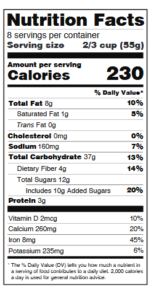More About the Updates to the Daily Values on Food Labels

By Reed Mangels, PhD, RD
Shortly after our post about updated Daily Values on food labels, we got a question from a reader who asked, “The FDA webpage you linked to highlights that the DV for total fat has been updated from 65 g to 78 g and the DV for sodium has been updated from 2,400 mg to 2,300 mg. Do you have any comments on those changes?”
As you may recall from an earlier post, the Nutrition Facts portion of a food label includes Daily Values which are established by the FDA to be used for the labels of foods and supplements. Daily Values are amounts of nutrients that people are recommended to consume or not to exceed each day.
In the most recent update, the Daily Value for total fat went from 65 grams to 78 grams of fat per day. Of course, this doesn’t mean that you need to eat more fat. Remember, in this case, this indicates an upper limit – don’t eat more than 78 grams of fat a day if you’re eating 2,000 calories a day. 2,000 calories is the amount the FDA decided to use as a guide for general nutrition advice.
We wondered why there was an increase in the upper limit for total fat. Some quick calculations showed us that if your diet has 65 grams of fat and 2,000 calories, your diet gets 30% of its calories from fat. If your diet has 78 grams of fat and 2,000 calories, your diet gets 35% of calories from fat.
The RDAs include recommendations for the acceptable macronutrient distribution range (AMDR) – the percentage of calories that should come from protein, fat and carbohydrate. The AMDR for total fat is 20-35% of calories (1). Since 35% appears to be the upper limit, that is likely why 78 grams of fat (35% of 2,000 calories) was used as the DV.
The change in the sodium DV is due to a new recommendation for sodium. In 2019, the National Academies of Sciences, Engineering, and Medicine, (the non-profit organization that makes nutrition recommendations for the United States) developed a new method for evaluating dietary intake called the Chronic Disease Risk Reduction Intake (CDRR). The CDRR is defined as the lowest level of intake for which there was strong enough evidence to say that above this intake, there is a greater risk of chronic disease (2).
There is strong evidence that reducing sodium intake reduces blood pressure (2,3). The CDRR for adults for sodium is 2,300 mg/d; above this level of intake, a reduction in sodium intake is recommended. This new recommendation appears to be the reason that the DV for sodium was changed to 2,300 milligrams.
As was the case for fat, this does not mean that you must take in the DV for sodium daily to be healthy. It means that you should reduce your sodium intake so that it is below 2,300 milligrams.
References
- Institute of Medicine Food and Nutrition Board. Dietary Reference Intakes for Energy, Carbohydrate, Fiber, Fat, Fatty Acids, Cholesterol, Protein, and Amino Acids. Washington, DC: National Academy Press; 2002.
- National Academies of Sciences, Engineering, and Medicine. Dietary Reference Intakes for Sodium and Potassium. Washington, DC: The National Academies Press. 2019.
- Newberry SJ, Chung M, Anderson CAM, et al. Sodium and Potassium Intake: Effects on Chronic Disease Outcomes and Risks. Comparative Effectiveness Review No. 206. (Prepared by the RAND Southern California Evidence-based Practice Center under Contract No. 290-2015-00010-I.) AHRQ Publication No. 18-EHC009-EF. Rockville, MD: Agency for Healthcare Research and Quality; June 2018.
